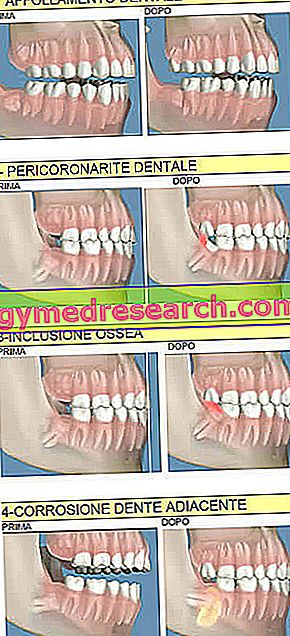Premise
The irrepressible anguish that is often hidden behind the extraction of a wisdom tooth is a fact.
We are talking about a surgical operation which consists in the literal removal of one or more wisdom teeth (the so-called third molars) from the mouth. Today, the extraction of a wisdom tooth is included in the list of routine dental operations; therefore, the experience acquired by a doctor in performing such dental operations should immediately calm the patient.
In the course of the article we will try to understand why it is advantageous to undergo an extraction of the wisdom tooth even in the absence of pathologies in progress. Next, we will describe how to prepare for a third molar extraction, what the intervention consists of, and what risks and complications occur.
Let us briefly recall that the third molars, absent in the newborn's dentition, begin between the ages of 18 and 25 (not surprisingly, they are called wisdom teeth), an age in which all the dental elements are placed in a precise position. The impetuosity with which wisdom teeth erupt from the gums could cause toothache, dental crowding and many other disorders, such as to make a dental extraction necessary.
When is it inevitable?
The extraction of wisdom teeth (also called avulsion ) can be performed for preventive or curative purposes. In the first case, a wisdom tooth can be removed to safeguard the correct position and the right alignment of the other teeth, minimizing the risk of dental malocclusion and crooked teeth. Moreover, an early extraction of wisdom teeth (immediately after their extrusion from the gingiva) can be recommended by the dentist to limit any risks and complications that could instead arise by removing a third molar already fully formed during adulthood.
For therapeutic purposes, the extraction of wisdom teeth is inevitable in the following circumstances:

- Corrosion of the adjacent tooth: a wisdom tooth, still included in the gingiva, pushes forcefully against the roots of the adjacent tooth, creating inflammation and pain that require extraction
- Severe al dente infection, caries, pulpitis, dental abscess or wisdom tooth granuloma: in these cases, removal of the infected tooth is the only adequate solution. A filling or a devitalization would, instead, be superfluous interventions for a wisdom tooth
- Dental inclusion: the wisdom tooth is blocked in its path of growth and development from the gingiva, remaining trapped inside the mandibular or maxillary bone. This condition exposes the tooth to the risk of infections, caries, dental abscesses and cysts
- Gingival inflammation caused by the misplacing of a wisdom tooth
- Chronic toothache, caused by the pressure exerted by the wisdom tooth on adjacent teeth
- Dental pericoronitis: a partially erupted wisdom tooth can give rise to a very annoying and painful acute gingival inflammation
- Breakage or chipping of the wisdom tooth
What should you know
Although relatively simple, extracting a wisdom tooth is a full-fledged surgical procedure and as such requires some preliminary preparation.
Result of extraction, complications and post-operative course depend on several factors, listed below:
- Doctor's experience
- General state of health of the patient (current pathologies, medication, pregnancy, etc.)
- Degree of development of the roots of the tooth to be removed
- Implementation of all precautions that precede the removal of the wisdom tooth
- Observance of useful tips to minimize the risk of complications after wisdom tooth extraction
The specialist examination of the oral cavity supported by the radiographic study allows the doctor to evaluate with absolute precision the position and health of the wisdom tooth: in this way, it is possible to understand whether the tooth to be removed is pathological or not.
- The patient must be made aware of all the risks and complications that could occur after the extraction of a wisdom tooth.
The extraction of a third molar can give rise to post-surgery pain, small hemorrhages, alter the position of the adjacent teeth and temporarily reduce the masticatory capacity.
Before proceeding with the intervention, it is necessary - and indispensable - to always address to the dentist all doubts, concerns and uncertainties. It is recommended to always inform the doctor in the presence of allergies to drugs or materials (eg latex allergy, nickel allergy), illnesses (past or current) and any interesting state (presumed or ongoing pregnancy). Furthermore, it is equally important to report to the dentist if you are taking medication for a given disease.
Preparation for surgery
Before extracting a wisdom tooth, it is the duty of the physician to instruct the patient on all possible precautions to be taken to prevent post-operative complications.
First of all, the CLEANING OF THE ORAL CABLE is very important to significantly reduce the possibility of bacterial insults to the mouth. To avoid this inconvenience, it is advisable to support daily dental hygiene with rinses of medicated-disinfectant mouthwashes (formulated for example with chlorhexidine) in the 4 days preceding the extraction of the wisdom tooth.
Again, some dentists even prescribe a prophylactic antibiotic treatment (BEFORE dental extraction) to reduce the risk of infection (especially if the wisdom tooth extraction procedure is particularly invasive or complex).
During the surgery
The extraction of a wisdom tooth can be performed in specialized dental offices or in hospitals. In most cases, wisdom tooth extractions are performed under local anesthesia, which is essential to effectively combat pain during the operation. Exceptions are not lacking: some non-collaborative, dental phobic patients (who suffer a fierce fear of the dentist) or who tend to vomit require intervention under general anesthesia.
As soon as the anesthetic begins to act, the doctor proceeds with the extraction of the wisdom tooth using special surgical instruments. If the wisdom tooth is still stuck in the bone (tooth included), the extraction must be preceded by the incision of the gingiva.
The lower wisdom teeth are generally more difficult to eliminate, particularly if they are still incorporated in the jaw. In such circumstances, the tooth is generally reduced to several pieces in order to facilitate its avulsion. After extraction of the wisdom tooth, some stitches can be applied to limit bleeding as much as possible.
Risks after the extraction of a wisdom tooth
After the extraction of a wisdom tooth, the speed of recovery is closely linked to the degree of difficulty of the intervention: extracting a wisdom tooth included (not yet checked), for example, can sometimes be more problematic than removing a tooth completely erupted.
Summary of the most common symptoms after a wisdom tooth extraction
- Pain: may also persist for a few days
- Edema / Swelling (duration 1-7 days)
- Gingival bleeding (max. Duration 24 hours)
- Post-extraction alveolitis (3-4 days after surgery)
- Infection
- Tooth abscess
- Injuries to the roots of teeth close to that of judgment
- Temporary loss of sensitivity of the lip and tongue
Also possible morbid conditions can heavily affect the post-dental extraction course: patients affected by systemic pathologies (eg diabetes, autoimmune diseases, chronic renal failure, etc.), as well as subjects undergoing chemo / radiotherapy or who have to take corticosteroid drugs, can present considerable recovery difficulties after the extraction of a wisdom tooth.
After the avulsion intervention, the swelling - often associated with small hematomas - is a rather frequent possibility; however, the edema tends to resolve within a short time (1-3 days). Within certain limits, gingival bleeding is also considered a normal post-extraction complication: when it is mild, bleeding resolves within 24 hours of surgery.
Swelling and gingival hemorrhage after a wisdom tooth extraction are often accompanied by pain, which reaches its peak when the effect of anesthesia wears off. Taking a painkiller (eg ibuprofen) before the effect of the anesthetic fades completely proves to be extremely important for masking or reducing pain.
Even infections are generally a fairly common risk after the extraction of a wisdom tooth; among these, a major role is played by alveolitis, namely the alveolus infection (the bone cavity where the tooth roots are housed) and the dental abscess.
In more rare cases, the extraction of a wisdom tooth (especially if included) can give rise to the formation of cysts, rounded cavities that progressively expand in the bone, destroying it.
In the event that, during the extraction of a wisdom tooth, the molar roots (adjacent to the extracted tooth) were injured or damaged, the patient may experience complications. Among these, the most common is undoubtedly the temporary loss of sensitivity of the lip or tongue (to the side where the wisdom tooth is extracted).




